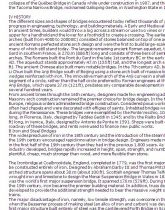Vypracované otázky: Bridges - anglický jazyk
Skryť detaily | Obľúbený- Kvalita:71,8 %
- Typ:Vypracované otázky
- Kategória:Jazyky
- Podkategória:Angličtina
- Predmet:Anglický jazyk
- Dokumentácia:Stiahni
- Rozsah A4:9 strán
- Zobrazené:1 003 x
- Stiahnuté:1 x
- Veľkosť:0,1 MB
- Formát a prípona:MS Office Word (.doc)
- Jazyk:anglický
- ID projektu:912
- Posledna úprava:12.07.2017
I INTRODUCTION
Bridge (structure), structure designed to provide continuous passage over an obstacle. Bridges commonly carry highways, railroad lines, and pathways over obstacles such as waterways, deep valleys, and other transportation routes. Bridges may also carry water, support power cables, or house telecommunications lines.
Some special types of bridges are defined according to function. An overpass allows one transportation route, such as a highway or railroad line, to cross over another without traffic interference between the two routes. The overpass elevates one route to provide clearance to traffic on the lower level. An aqueduct transports water. Aqueducts have historically been used to supply drinking water to densely populated areas. A viaduct carries a railroad or highway over a land obstruction, such as a valley.
The earliest bridges were simple structures created by spanning a gap with timber or rope. Designs became more complex as builders developed new construction methods and discovered better materials. The stone arch was the first major advance in bridge design. It was used by the ancient Greeks, Etruscans, and Chinese (see Arch and Vault).
The Romans perfected arch design, using arches to build massive stone bridges throughout the Roman Empire. Stone arch construction remained the premier bridge design until the introduction of the steam locomotive in the early 19th century.
Bridge (structure), structure designed to provide continuous passage over an obstacle. Bridges commonly carry highways, railroad lines, and pathways over obstacles such as waterways, deep valleys, and other transportation routes. Bridges may also carry water, support power cables, or house telecommunications lines.
Some special types of bridges are defined according to function. An overpass allows one transportation route, such as a highway or railroad line, to cross over another without traffic interference between the two routes. The overpass elevates one route to provide clearance to traffic on the lower level. An aqueduct transports water. Aqueducts have historically been used to supply drinking water to densely populated areas. A viaduct carries a railroad or highway over a land obstruction, such as a valley.
The earliest bridges were simple structures created by spanning a gap with timber or rope. Designs became more complex as builders developed new construction methods and discovered better materials. The stone arch was the first major advance in bridge design. It was used by the ancient Greeks, Etruscans, and Chinese (see Arch and Vault).
The Romans perfected arch design, using arches to build massive stone bridges throughout the Roman Empire. Stone arch construction remained the premier bridge design until the introduction of the steam locomotive in the early 19th century.
Kľúčové slová:


